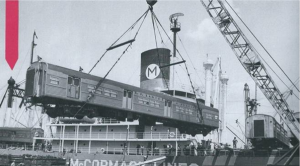 The shiny new Budd-built commuter cars are being loaded aboard a ship destined to Brazil. Brazilian railroads have both broad-gauge and standard-gauge. These cars appear to be standard, meaning 4 foot – 8-1/2 inches between the rails. In 1957 Brazil had the eighth-longest rail transport network in the world.
The shiny new Budd-built commuter cars are being loaded aboard a ship destined to Brazil. Brazilian railroads have both broad-gauge and standard-gauge. These cars appear to be standard, meaning 4 foot – 8-1/2 inches between the rails. In 1957 Brazil had the eighth-longest rail transport network in the world.
The Budd Company produced a wide variety of passenger equipment including the popular dome cars that AMTRAK retired. Personally, I liked to be able to see forward, over the top of the train as it careened across the country, even after dark.
Why the arrow, you ask.? The arrow is pointing to the rear mast. Large ships of the 20th Century were built with the pilot house and creature comforts, amidships. Most had two masts forward and a single astern. Notice the upper portion of the single mast astern is blackened. This was typical, as was the forward masts and bow of ocean-going ships painted white with a large band from the most forward point back to the first step along the gunwales, (the top edge of the side of a boat).
The reason for the blackened rear mast and the bright white forward was to provide a vivid image from afar during daylight hours. It’s a big ocean out there, and your eyes can play tricks on you. It’s extremely important for the helmsman to know precisely the attitude of any nearby traffic. From the bridge of your ship when you could see the white bow and super-structure, you knew the far-off ship was facing you. In hours of darkness red, green navigation lights provide the visual.
Large ships built today usually place the pilot house and all amenities positioned at the stern. Some of the reasons: from the stern the Captain has a better feel of control, particularly when docking, and the propulsion source is near the propeller, eliminating a lengthy drive shaft and housing that could affect the lading capacity. Photographer unknown
From Gary O. Ostlund
